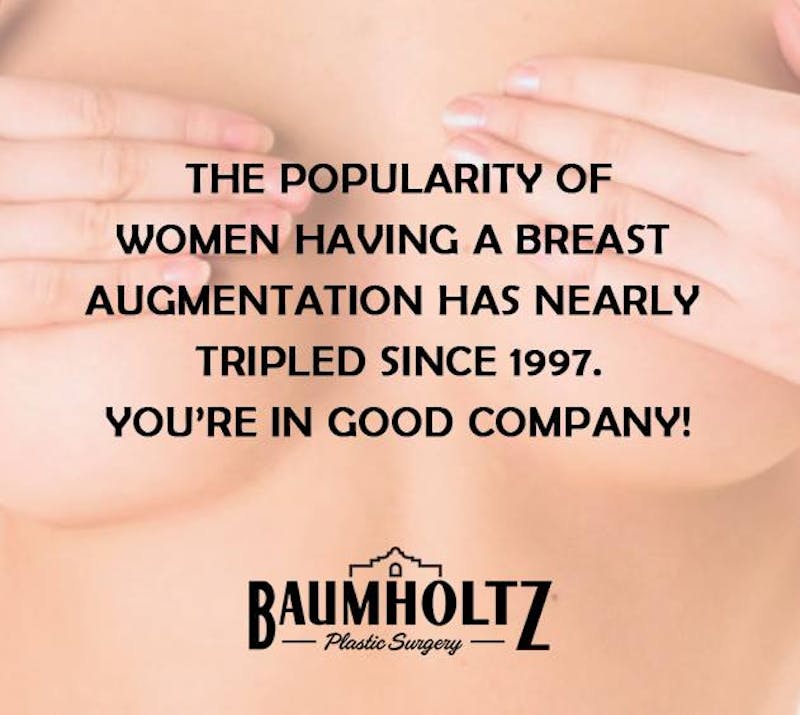Considering Breast Augmentation? Know Your Options
Curves are in! That’s the word from New York Fashion Week and Culture Map San Antonio, which featured a lineup of 2018 fashions making their debut on the catwalks earlier this season (you can get a sneak peak on their website). If you’ve been thinking about breast augmentation, now’s a great time: Designers worldwide are moving away from the androgynous look of the 1960s-early 2000s and embracing women’s curves, so you can look great and feel your confident best. Breast augmentation is the top cosmetic procedure in the U.S., with nearly 300,000 women opting for enhancement each year, according to data from the American Society of Plastic Surgeons. If you’re thinking about having breast augmentation surgery within the next few months, you’ve got some homework to do. One of the most important decisions is selecting the best surgeon for your needs. And you’ll also need to learn as much as you can about your options when it comes to the type of implants that will be used in your surgery. At Baumholtz Plastic Surgery, we offer the most advanced implants to help ensure you get the best results while also keeping your safety in mind. Here’s a brief review of some of the breast augmentation options we offer at our practice:
Silicone Implants
Silicone implants have been around for many years, but that doesn’t mean they haven’t changed. Today’s silicone implants offer a more durable structure and construction to prevent damage and leakage, and they’re also available in an array of sizes and profiles to help women achieve a custom look that suits their body shape as well as their personal goals. Silicone breast implants have remained a favorite among patients throughout the years, thanks to a very natural feel that’s very much like natural breast material. The silicone material is inert, and free from risks of allergic reaction or rejection. Because of their size, silicone implants require a larger incision than saline implants, which are inserted “empty” and filled with saline after they’re in position. Under FDA guidelines, patients must be 22 years of age or older to have silicone implants used in their breast augmentation surgery.
Saline Implants
Saline implants are filled with sterile saline solution (salt water). While silicone implants are more gel-like, saline implants are filled with liquid, which means if they become damaged and leak, the implant will deflate. Saline implants use a silicone “shell” that’s inserted through a very small incision. Once the implant is in place, it’s filled with saline solution to achieve the desired size. If you have very thin skin, there’s a chance small “dimpled” areas or other minor imperfections may be felt beneath the skin. This is often referred to as “rippling.” Some patients find saline implants don’t feel as much like real breasts as silicone implants, but other women find the difference negligible. Saline implants are available for patients who are at least 18 years of age.
Allergan Implants
Allergan Natrelle® implants were approved by the FDA in 2016, capitalizing on recent advances in design and technology to provide women with multiple options and a natural feel and appearance. Allergan round implants are available in both a classic style and the INSPIRA® style for added fullness without compromising the soft, natural feel. Natrelle implants use a gel-like silicone material that retains its shape even if the implant is damaged. Sometimes, these implants are referred to as “gummy” implants because the consistency is more like a jelly candy than the more liquid-like material used in some other types of silicone implants. In the unlikely event an implant becomes damaged after implantation, the gel interior enables the breast to retain its curved shape until the implant can be removed and replaced.
Round vs. Teardrop
Teardrop implants are often marketed as the preferred shape for breast implants because the shape is more like the shape of your natural breast. The problem is, if a teardrop implant shifts, your breast contours will shift with the implant, resulting in an uneven appearance that can really detract from your results. Round implants eliminate the problem because even if they shift or rotate, the round shape will be maintained. Round implants also offer fullness in the upper portion of the breast, resulting in a more voluptuous contour which is a look many women prefer.
Smooth vs. Textured
Textured implants have a rougher surface texture, and when they were first introduced, most surgeons felt they might be an improvement over smooth implants. That’s because the textured surface helps the implant “grip” the surrounding tissue, helping the implants stay in place to prevent rotation and shifting. Some studies also indicated these implants were less likely to develop a tight “capsule” of scar tissue compared to smooth implants. However, more recently, textured implants have been linked with an increased risk of breast implant-associated anaplastic large cell lymphoma (BIA-ALCL), a rare type of cancer that affects the lymph system. In fact, the FDA issued a statement regarding the possible link between textured implants and BIA-ALCL. As a result of these safety concerns, we use only smooth implants in our practice.
Fat Transfer: Adjunctive Option
Although some cosmetic surgery practices advertise fat transfer as a potential option for breast augmentation, it’s generally a better option for “touching up” or “fine-tuning” an augmentation using saline or silicone implants. Why? There are a few reasons:
- Most women don’t have enough viable, “harvestable” fat to achieve the breast size they’re interested in. Not all fat can be used for fat transfer procedures, and for most women, fat transfer offers only a minor size increase that typically falls far short of the results they’re looking for.
- Fat transfer typically requires two or three surgeries to transfer an adequate amount of fat. Even with the most advanced surgical techniques, not all grafted material is going to survive after transfer. That means you’ll probably need additional surgeries to transfer more fat to make up for the graft material that doesn’t “take” after the first surgery. More surgeries mean higher costs, more downtime and more discomfort – not only in the breast area, but in the areas where fat is harvested as well.
- Fat alone doesn’t provide the rounded, natural breast shape that can be achieved with implants. As a result, you may not be satisfied with the end result.
Although fat transfer isn’t necessarily the best choice for complete augmentation, it can be very useful when used in conjunction with silicone or saline implants. For instance, fat transfer can improve modest differences in symmetry or shape, or it can be used to smooth out contours around the edges of an implant.
Learn more about breast augmentation options.
To learn more about the Baumholtz Plastic Surgery treatments and procedures performed by Board Certified Plastic Surgeon and Reconstructive Surgeon, Dr. Michael Baumholtz please contact us.
View our plastic surgery and med spa procedure pricing.
Dr. Baumholtz receives patients from San Antonio, Shavano Park, Texas and surrounding areas.


